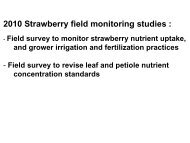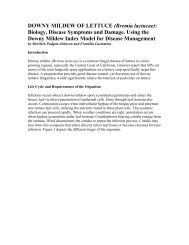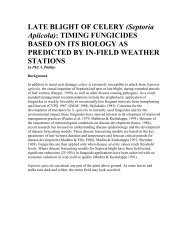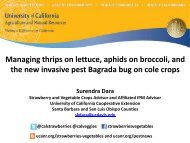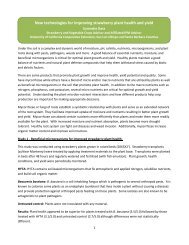Organic Strawberry Pest Management - Santa Barbara County ...
Organic Strawberry Pest Management - Santa Barbara County ...
Organic Strawberry Pest Management - Santa Barbara County ...
You also want an ePaper? Increase the reach of your titles
YUMPU automatically turns print PDFs into web optimized ePapers that Google loves.
<strong>Management</strong> of Arthropod <strong>Pest</strong>s<br />
in <strong>Organic</strong> <strong>Strawberry</strong><br />
Hugh Smith<br />
Farm Advisor<br />
Vegetables and Strawberries<br />
<strong>Santa</strong> <strong>Barbara</strong> and San Luis Obispo<br />
Counties<br />
University of California Cooperative<br />
Extension
Principle of organic agriculture:<br />
Diversity increases stability<br />
• Is crop diversity important for pest<br />
suppression in organic strawberry?<br />
• Can we use crop combinations to put<br />
strawberry pests at a disadvantage?<br />
• Can we use insectary plants to enhance<br />
biological control of pests in organic<br />
strawberry?
<strong>Strawberry</strong> pests<br />
● twospotted spider mite,<br />
strawberry cyclamen mite<br />
● Lygus<br />
● corn earworm, beet armyworm<br />
● whiteflies<br />
● thrips<br />
• light brown apple moth
Twospotted spider mite,<br />
Tetranychus urticae<br />
Life cycle<br />
University of Minnesota<br />
Host range: many vegetable, field and<br />
tree crops
Factors favoring spider mites<br />
● Dust<br />
● Hot/Dry<br />
● Wind<br />
Importance of wind breaks, dust<br />
barriers.<br />
Vigorous strawberry plants are better<br />
able to withstand mite damage.
Damage – spider mites puncture plant cells to<br />
drink sap.
INRA, France
Monitoring spider mites<br />
Examine leaves in the middle of the plant,<br />
underside.<br />
10 plants/acre in small fields; 5 plants/acre<br />
large fields.<br />
Thresholds according to UC:<br />
4-5 months after transplanting: average of 5<br />
mites/leaf<br />
Summer transplants: average 10 mites/leaf<br />
60% Persimilis?
Carmine spider mite – rarely causes damage
Predatory mite Persimilis (right)
Predatory mite Galendromus
Suppliers of mite predators:<br />
• Biotactics<br />
• Rincon Vitova<br />
• Syngenta<br />
• Kuida Ag (distributors)<br />
Others…
Rates? Thousands per acre…<br />
Frequency?<br />
There are many approaches to<br />
managing spider mites with<br />
predatory mites.<br />
Different predatory mites have<br />
different characteristics:<br />
best for strawberry?
Other predators
Good Bug Blend for mite management?
<strong>Organic</strong> acaricides:<br />
Rosemary oil (no residual)<br />
<strong>Organic</strong> stylet oils<br />
Efficacy?
Lygus<br />
(Lygus hesperus)
Lygus<br />
Incomplete metamorphosis<br />
Courtesy Frank Zalom
Lygus Sources<br />
Infested second year plantings<br />
Weedy hosts around fields<br />
Alternate host crops<br />
Mustards &<br />
wild radish<br />
Pepperweed<br />
Courtesy Frank Zalom
Monitoring guidelines<br />
Sweep net - for weeds, trap crops,<br />
and other crops<br />
Beating hoop or tray - strawberries<br />
A-vac (or other suction devices) -<br />
strawberries<br />
A-vac<br />
Courtesy Frank Zalom<br />
Beating hoop or tray
Alfalfa Interplants in Cotton - Studied since the late 1960s<br />
Grow 20' strip for every 300'<br />
Mow 1/2 every 14 days<br />
Leave unmowed strip<br />
Courtesy Frank Zalom
Bug Vacs<br />
Two row bug vac<br />
Courtesy Frank Zalom<br />
Three row bug vac<br />
One row bug vac
Swezey et al. 2007. Environmental<br />
Entomology<br />
• 3 year Lygus study<br />
• Twice-weekly vacuuming of alfalfa trap<br />
crop in strawberry<br />
• Adults reduced by 72%<br />
• Nymphs reduced by 90%<br />
• Less damage<br />
• Cheaper than vacuuming entire field
● ● ● ● ● ● ● ● ● ●<br />
Sampling Lygus in <strong>Strawberry</strong>, UC <strong>Management</strong> Guidelines<br />
200<br />
feet<br />
● ● ● ● ● ● ● ● ● ●<br />
● ● ● ● ● ● ● ● ● ●<br />
● ● ● ● ● ● ● ● ● ●<br />
UC threshold: 1 nymph/10 plants (beating)
Degree Days: combining scouting and temperature<br />
information to predict Lygus development<br />
Lower<br />
temperature<br />
threshold for<br />
Lygus: 54º F
Degree-day Accumulations (> 54 o F) Required for<br />
Each Stage of Lygus Development<br />
Developmental stage DD ( o F) DD ( o C)<br />
Eggs: 252.0 140.0<br />
Nymphs: 371.0 206.1<br />
Egg to Adult: 623.0 346.1<br />
Pre-Oviposition: 176.0 97.8<br />
(Egg to Egg): 799.0 443.9<br />
Lygus Phenology Model after Sevacherian et al.<br />
URL - http://ipm.ucdavis.edu/WEATHER/ddretrieve.html
Spring<br />
Biofix 2<br />
Biofix 1<br />
Late<br />
Winter<br />
Using the Lygus<br />
DD model<br />
Fall planted berries
Vacuuming:<br />
• Destroys beneficials<br />
• Spreads powdery mildew<br />
Alfalfa:<br />
Can be a source of thrips
Egg parasitoid is commercially<br />
available – efficacy?<br />
Anaphes iole, laying<br />
egg in Lygus egg.
<strong>Organic</strong> insecticides for Lygus:<br />
M-Pede, insecticidal soap.<br />
May kill up to 50% nymphs.<br />
Will not impact adults.<br />
Lygus builds up in second year<br />
berries.
Good Bug Blend for Lygus<br />
management?
Beet<br />
armyworm<br />
(Spodoptera<br />
frugiperda),<br />
Corn earworm<br />
(Helicoverpa<br />
zea)<br />
Each has a broad<br />
host range.
Beet<br />
armyworm egg<br />
mass<br />
Corn<br />
earworm:<br />
eggs laid<br />
singly
Beet army worm<br />
Smooth; black spot<br />
above second leg<br />
Corn earworm<br />
Dark tubercles<br />
and bristles,<br />
color variable
Beet armyworm and corn<br />
earworm<br />
Eggs, larvae: attacked by several<br />
parasitoids and predators.<br />
Attacked by pathogens.<br />
Bt and Entrust (spinosad) can be<br />
used in organic production.<br />
Young larvae must be targeted.
Greenhouse whitefly (Trialeurodes vaporariorum)<br />
Adults and eggs<br />
Nymphs<br />
Parasitized nymphs<br />
Red-eyed nymphs or pupae
Whitefly damage:<br />
crop debilitation<br />
Whiteflies build up<br />
on second year<br />
berries.<br />
Sooty mold<br />
Wintermantel<br />
Zalom<br />
pallidosis related decline
Whitefly control in organic strawberry:<br />
“Preserving naturally occurring biological<br />
control agents, cultural controls,<br />
sprays of narrow range oil, azadirachtin<br />
(Neemix), and insecticidal soaps,<br />
and releases of Encarsia formosa into hot<br />
spots against low-to-moderate<br />
populations of greenhouse whitefly<br />
are acceptable for use on organically<br />
certified strawberries.”
Western<br />
flower thrips<br />
(Frankliniella<br />
occidentalis)<br />
Control:<br />
Spinosad,<br />
predators<br />
Type 1<br />
bronzing
Thrips can build up in alfalfa.
Light brown apple moth (Epiphyas vittata)<br />
Female<br />
Male<br />
Fotos: David Williams, Principal Scientist, Perennial<br />
Horticulture, Department of Primary Industries, Victoria, Australia<br />
Egg cluster Hortnet, New Zealand<br />
Pupa Hortnet, New Zealand<br />
Larva Macleay Museum, University of Sydney
Insectaries with strawberry?<br />
Lygus<br />
Beet armyworm<br />
Spider mites<br />
Whiteflies





